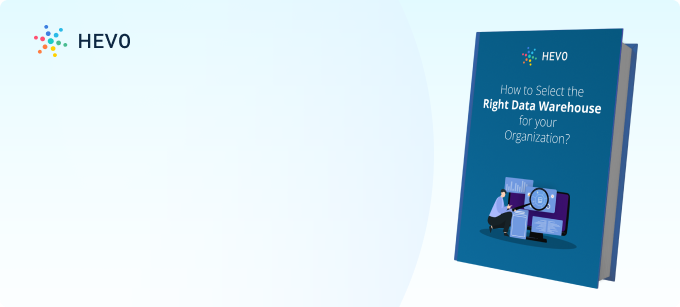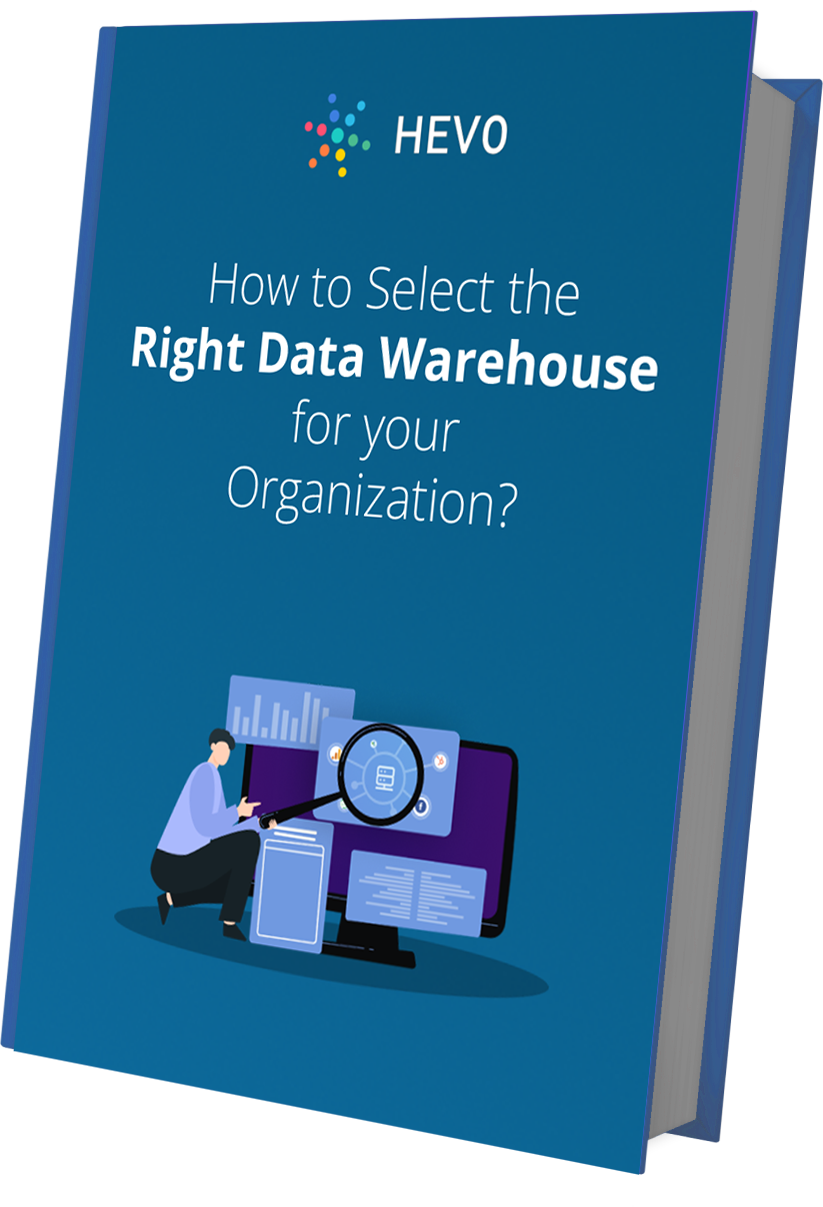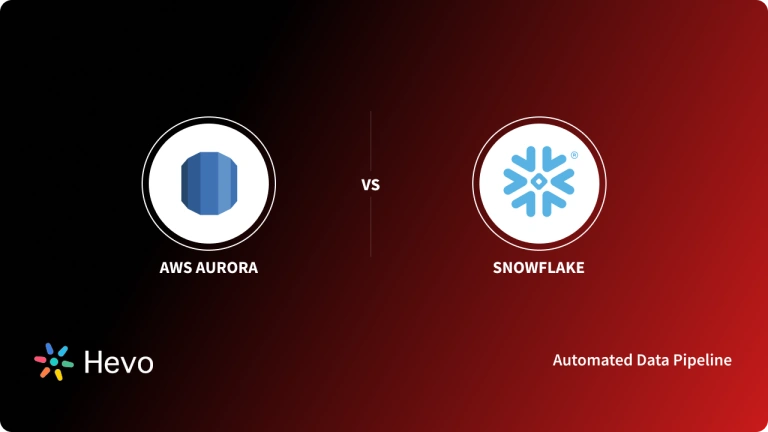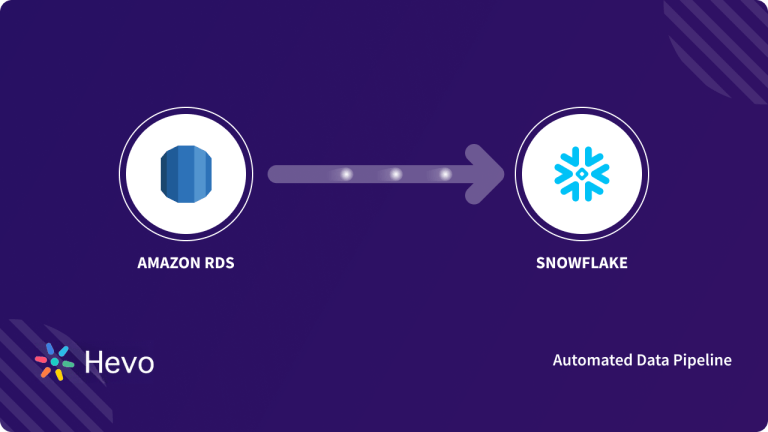Database-as-a-service (DBaaS) cloud services give users an opportunity to use databases without having to configure physical infrastructure and without installing any software. This brings a lot of convenience to many individuals and companies. Since organizations are in need of reducing operational costs, DBaaS has become the best alternative to data storage in most organizations.
Amazon is the leading provider of DBaaS cloud services. Since DBaaS is in high demand, individuals and companies always find themselves stuck between Aurora and RDS. When figuring out which solution best fits your organization, there are many factors that should be considered. In this article, we will be discussing the differences between Amazon Aurora and RDS.

With Hevo, you can effortlessly export your Aurora or RDS data to any destination, such as BigQuery, Redshift, Snowflake, and many more. Our no-code platform ensures smooth and efficient data integration and transformation.
- Seamless Export: Transfer your data to your target destination in 2 Steps.
- Flexible Transformations: Use drag-and-drop tools or custom Python scripts for data preparation.
- Real-Time Data Ingestion: Keep your data current with real-time synchronization.
Join over 2000 satisfied customers, including companies like Cure.Fit and Pelago, who trust Hevo for their data management needs.
Get Started with Hevo for FreeTable of Contents
Amazon Aurora Vs RDS
RDS is a hosted database service with multiple flavors of relational database management systems including PostgreSQL, Aurora, MariaDB, and others. Although there are performance benefits that enterprises enjoy for hosting databases on RDS, Aurora comes with even newer tricks. In this article, we will be discussing how Aurora compares with RDS:
1. Performance
Subpar performance is not what any user wants for his/her database application. So first we will talk about the very crucial performance factor for the 2 databases. Amazon Aurora gives two times the throughput provided by PostgreSQL or five times the throughput provided by standard MySQL running on similar hardware.
RDS uses SSDs in its database services for better IO throughput. With Amazon RDS, you can choose between two SSD-backed storage options, that is, one that is optimized for high-performance OLTP applications and another one for cost-effective general-purpose use.
2. Compatibility with Database Engines
Databases are used to gather complete data put together from multiple sources so that Analysts can get a complete view of an organization’s progress. So, it is important to understand the different types of databases that are compatible with Aurora and RDS.
When migrating your on-premises databases to the cloud or from RDS to Amazon Aurora, you should meet your service-level-agreements (SLAs). All steps should be performed with no or minimal downtime.
Aurora is compatible with two DBMSs namely PostgreSQL and MySQL. It is compatible with PostgreSQL 9.6.1 and MySQL 5.6. This means that you can run your existing database tools and applications on Aurora without any modifications.
On the other hand, Amazon RDS requires you to use AWS Database Migration Service to migrate from EC2-hosted or on-premises databases such as PostgreSQL, SQL Server, or MySQL to it.
3. Storage Auto-Scaling
One of the main reason why Cloud Storage has seen a increased usage inclination rate is because of the ease of Auto-Scaling. Auto-Scaling lets you scale up or down as per your organizations requirements. Cloud helps you save a lot or resources and time with the Auto-Scaling feature.
Amazon Aurora can grow its storage from its minimum of 10 GB to a maximum of 64 TB depending on your database usage. This is done in increments of 10 GB without any impact on the database performance. You are not required to provide the storage in advance. This means that the DBA doesn’t have to predict and provision the storage needed for uninterrupted business operations.
On the other hand, RDS requires DBAs to provision even up to 6 TB of storage on-the-fly with no downtime. However, note that Aurora can only support the InnoDB storage engine, and it automatically converts tables from other storage engines into InnoDB.
4. Scalability
As a DBA, you must provision scalability while ensuring there is no downtime. Both Amazon Aurora and RDS allow you to scale the memory and compute resources down or up, up to a maximum of 244 GiB of RAM and 32 vCPUs. You can complete your compute scaling operations in just a few minutes with a few clicks.
5. AWS Aurora Vs RDS: Replication
Aurora supports two replica types, with the replicas sharing a similar underlying volume with the primary instance. Updates from the primary instance are made visible to all Aurora replicas. Aurora allows you to provision up to 15 replicas, and the replication is done in milliseconds. In Aurora, failover is done automatically to prevent data loss.
On the other hand, RDS only allows five replicas, and the process of replication is slower compared to Amazon Aurora. In RDS, failover is done manually which can lead to last-minute data loss.
Understanding the Limitations of AWS Aurora and RDS
Both Amazon Aurora and RDS have limitations. The following are the limitations of Amazon Aurora:
- Its small and medium sized instances are only suitable for testing or development due to their limited number of resources and connections.
- Some suboptimal or odd configuration values cannot be changed.
- A minimum of 5 minutes charge is applied every time the database is active, making it a bit expensive.
The following are the limitations of Amazon RDS:
- Patching causes downtime.
- It doesn’t support scale-out for the write workloads.
- The user has to perform some administrative tasks.
- A downtime is needed to perform scaling operations.
- There is no guarantee for zero data loss.
- It doesn’t support automated compression management.
Conclusion
In this article, you have learned about AWS Aurora and RDS. You have also learned to differentiate Aurora and RDS with the help of 5 key factors. In the end, this article also highlights the limitations of Aurora and RDS. Now you can consciously decide which database is best suitable for your use case.
Explore how to integrate Aurora MariaDB for improved reliability and speed in your database management.
Integrating and analyzing your data from a huge set of diverse sources can be challenging, this is where Hevo comes into the picture. Hevo is a No-code Data Pipeline and has awesome 150+ pre-built integrations that you can choose from. Hevo can help you integrate your sales data from numerous sources and load them into a destination to analyze real-time data with a BI tool and create your Dashboards. It will make your life easier and make data migration hassle-free. It is user-friendly, reliable, and secure. Check out the pricing details here.
FAQs
What is the difference between Aurora and RDS?
Amazon RDS is a managed relational database service supporting several database engines, including MySQL and PostgreSQL. Aurora, part of RDS, is Amazon’s proprietary, MySQL- and PostgreSQL-compatible database with higher performance and scalability features.
Is Aurora a part of RDS?
Yes, Amazon Aurora is part of Amazon RDS (Relational Database Service) and benefits from RDS features like automated backups, scaling, and monitoring.
Which is more expensive, RDS or Aurora?
Generally, Aurora is more expensive than standard RDS instances because of its high availability, performance, and storage efficiency. However, the total cost can vary based on usage and scaling needs.










